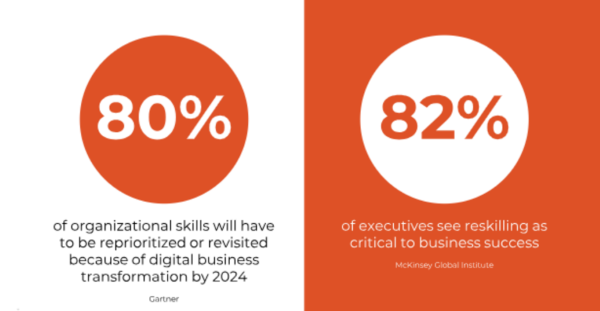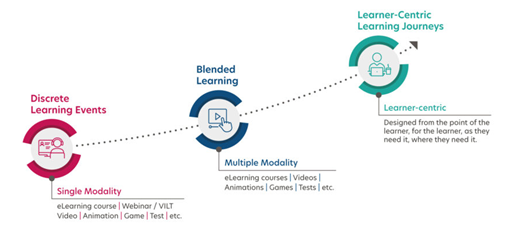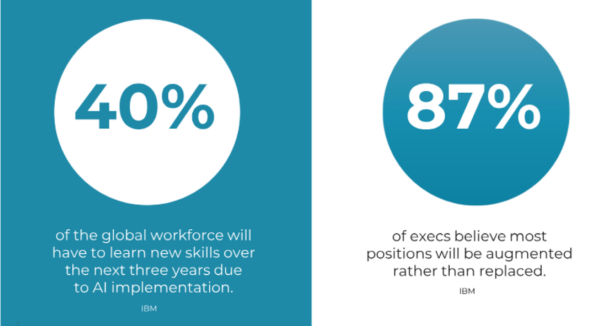As the saying goes, the only thing constant in life is change. This is certainly true in business. Organizations are experiencing a rapid change in the skills they need to succeed and facing the challenge of keeping their workforce equipped with those skills.
It’s up to learning professionals to help close these skills gaps. Hiring new talent is one common tactic. But many organizations see upskilling (improving current skills) and reskilling (learning new skills) as essential strategies to help close these gaps. According to a McKinsey Global Institute report, 82% of executives see reskilling as critical to business success.

Clearly, business leadership is aware of the need for reskilling. But few organizations understand how to get started. Our seven crucial steps to guide your organization’s reskilling initiatives can help, whether you’re a manager, director, or head of learning and development (L&D).
Step 1: Assess the Skills Gap
The first thing you need to do is identify the existing skills in your workforce. Before embarking on any reskilling program, start by assessing your workforce and conducting a skills inventory. It will help you to better understand which skills to focus on.
Reskilling to transform your workforce takes time and effort. You’ll need to engage leaders, managers, and employees in the process, and use data-driven insights for a targeted approach. A capability map visually represents an organization’s capabilities and can provide an ideal model for your organization’s specific functions and roles.
Be proactive to stay ahead of industry changes. Try to anticipate future skill requirements based on emerging trends, challenges, and opportunities in your industry.
Step 2: Align Skills with Business Goals
When reskilling your workforce, be sure to align your skills development efforts with your organization’s business goals.
Integrate your organization’s vision and mission into your reskilling strategy. Consider short-term and long-term goals and tailor your reskilling initiatives to support these objectives. The key lies in defining clear, measurable goals for skill development. Doing so provides a roadmap for future progress.
Amazon, for example, has committed to a $1.2 billion investment in reskilling and upskilling its employees by 2025. This initiative will develop their technical skills, enabling them to take on new positions in IT support and software engineering.
Transformation does not happen overnight. Be sure to design programs that can evolve with your organization’s demands. This ensures flexibility and adaptability, aligning with the dynamic nature of the business landscape.
Step 3: Adopt a Learner-Centric Approach
Once you have your roadmap of outcomes and skills requirements, you can start to design meaningful and effective learner journeys.
For learning to be successful, your content must be 100% relevant and useful to the learner. A learner-centric approach tailors reskilling programs to each learner’s needs. Personalized learning content and adaptive learning pathways offer more effective learning. This leads to significantly better outcomes for today’s high-expectation workforce.
For the modern workforce, use each learner’s role, job scope, current level of expertise, and experience to define their unique learning needs. By placing a spotlight on personalized learning paths, you acknowledge each person’s unique requirements. This learner-centric approach fosters a more engaging and effective learning experience.

Tailored learning paths help to address specific skill gaps, ensuring relevance to individual roles. This approach enhances the practical application of acquired skills and promotes a sense of ownership and motivation among learners.
Step 4: Leverage Learning Technology
New learning technologies are transforming the corporate learning environment, providing L&D professionals with innovative new tools.
In today’s ever-evolving digital landscape, artificial intelligence (AI) is a transformative force. It’s reshaping industries and redefining how we live, work, and interact. According to a study by IBM, 40% of the global workforce will have to learn new skills over the next three years due to AI implementation.

Technology plays a pivotal role in reskilling by enhancing both efficiency and relevance. Cutting-edge platforms not only streamline the content creation process. They can also track progress, identify learning gaps, and personalize learning experiences that captivate and motivate learners. This engagement is crucial for effective skill retention and application in real-world scenarios.
There are many new and innovative methods of reskilling with eLearning. Leveraging games and gamification, as well as immersive and extended reality (XR) technologies, can add a whole new dimension to the way you connect with your learners. This can enhance the overall efficacy of reskilling programs.
Step 5: Create a Culture of Continuous Learning
Upskilling and reskilling are not one-time events. Organizations that create a culture of continuous learning are likelier than others to have success with reskilling.
This begins by fostering a leadership culture that values ongoing development. Leaders play a crucial role in championing these initiatives. Your leadership team should not only endorse but actively participate in reskilling programs, setting an example for the entire organization. When leaders champion continuous learning, it sends a powerful message.
Managers, too, play a critical role by actively supporting and participating in reskilling programs. Their engagement ensures that the learning culture permeates all levels of the organization.
Step 6: Promote Collaboration
Promoting collaboration across functions is pivotal in creating a dynamic and innovative work environment.
Fostering a collaborative culture encourages the sharing of ideas, expertise, and knowledge among team members, leading to enhanced problem-solving and creativity. Breaking down silos promotes cross-functional collaboration, essential in today’s interconnected workplaces. Google is known for its open dialogue and giving its people lots of autonomy. Their open office spaces, communal areas, and regular cross-functional meetings facilitate collaboration.
Mentorship programs, coaching, job shadowing, and cross-training all play a significant role in developing skills in a collaborative framework. Pairing experienced people with those seeking to develop specific skills not only accelerates learning. It also provides learners with valuable insights and guidance. They help foster a culture of continuous learning too, where knowledge is shared organically, contributing to the overall growth of individuals and the organization.
Step 7: Measure the Impact
Measuring the business impact of reskilling programs is critical to ongoing success.
Regular progress checks will reveal the impact of your reskilling efforts. You can adapt your strategies in real time, to better align with your business objectives. By emphasizing ongoing feedback mechanisms, you can refine and improve current initiatives, and gather valuable insights to enhance future reskilling programs.
Research tells us that over 90% of learning organizations want to measure business impact, but few can do it effectively. Establish clear metrics for reskilling success. A tangible evaluation framework will enable your organization to connect the dots between investment, business results, and strategic goals.

These metrics not only quantify the impact on individual and organizational performance. They also guide continuous improvement efforts. The value of ongoing feedback extends beyond program refinement. Feedback can also enhance the overall learning experience by tailoring content and approaches to meet the evolving needs of learners.
Upskilling and Reskilling are Investments in Your Organization’s Future
Many organizations are already seeing long-term benefits from investing in reskilling programs, both in terms of business impact and the effect on employee satisfaction and customer experience.
Reskilling is a forward-thinking strategy. It can propel your organization toward sustained growth and competitive advantage. By taking these seven essential steps, you will empower your workforce to thrive today and lay the groundwork needed to navigate future disruptions.
References:
